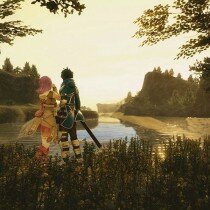Enchantingly memorable, “NieR” is a game not many have heard of—let alone experienced. Brimming with magnificently composed music, captivatingly developed characters, intricate attention to detail and engaging gameplay; “NieR” stands as a treasured adventure in the hearts and minds of those that played it.
From the very beginning, when you start a new game you are introduced to the breathtaking melodic soundtrack as well as a prologue of sorts taking place in the year 2049. It is here that we meet Yonah and Nier (who will go by any name you have decided to give him) in a frozen apocalyptic world. Depending on which console you got the game for Nier will be either Yonah’s father (Gestalt for the Xbox 360) or her brother (Replicant for the PlayStation 3). The differences between the versions end there with Nier’s age and relationship to Yonah—however the 360’s Gestalt version appears to be noticeably the most natural feeling later on in the story. Continuing with the prologue however, the player is taught how to play the game and eventually learns that Yonah is sick. Nearing the end of the prologue however, Yonah collapses and Nier calls for help.
Fast forward an alarming amount of years (the game specifies 1,312 years to be exact) and we are greeted to Nier and Yonah once more—although their clothes have changed and appear to be more primitive compared to their clothes within the prologue. Now I can imagine everyone’s confused reactions as to how these two can be alive after such a long time—in reality they aren’t the same Nier and Yonah in the prologue (which is explained late in the story and is so subtle that some may have even missed it in their first play through). Nevertheless, Yonah is sick with an illness known as the Black Scrawl in this time and Nier searches for a cure in order to save his daughter/sister.
The first half of the game focuses on Nier’s quest for a cure; eventually leading him to Kainé—a foul-mouthed, bad tempered intersex outcast—Emil—a young boy who can turn people and monsters into stone upon looking at them—and Grimoire Weiss—an ancient magical book that can talk (upon meeting and “obtaining” Grimoire Weiss the player is able to use magic). Together, they begin to look for an ancient and powerful magic known as the “Sealed Verses” in order to cure Yonah. However, transitioning into the second half of the game, time skips ahead five years with Yonah kidnapped by a being known as the Shadowlord and Nier and the others learning more about themselves and the others they came across. Throughout the duration of the second half of the game, Nier and the others gather pieces of the key to the Shadowlord’s lair all in order to eventually approach his “throne.”
I could go on days and days about the story of the game; however, I still need to discuss the gameplay of the game. Unlike many other RPGs published by Square Enix, “NieR” allows the player to completely control the main character—jumping, running, magic attacks, regular attacks, everything. Because of this, the game does require some skill in making the right moves and judging your own attacks and health. The majority of the RPG elements don’t actually come in until after you “obtain” Grimoire Weiss and are able to collect words. These words can be equipped to your weapons and magic skills in order to upgrade. This is where the majority of the RPG elements come in; however from the get-go you can equip any one-handed sword you come across.
As you progress throughout the game however, you’ll gain new magic abilities after fighting each boss within the first half of the game. These skills range from a giant hand to black spears springing from the ground to creating your own projectiles (with my favorite being those spears as they cover a wide range). It isn’t until the second half of the game that Nier can wield two-handed swords and lances however, but by the time you get to this point using these weapons can feel strange compared to the one-handed swords you’ve grown accustomed to since the beginning of the game. In spite of this, the two-handed swords and lances can be very rewarding weapons if you stick with them and give it time to become familiar with their play styles.
With all that has been said so far, there is still more as the game isn’t limited to the main story. Side quests are scattered throughout the game—most of them only asking you to deliver items to others or collect particular items or even the occasional “hunt down and kill this creature” quest. The game also allows you to fish, which IS required at one point within the game in order to progress but after that it’s completely optional. However, the fishing is simple enough to understand and sometimes done right fun; especially if you make fun of yourself when you play video games.
All-in-all, “NieR”—whether it be Gestalt or Replicant—is an alluringly constructed game that I hold dear to my heart. From the characters, to the music, to the landscapes and levels, to the gameplay. Yes, there are problems on occasion (especially with loading and sometimes lag) and yes the story can be confusing at times—and I will be the first to admit it, but this game isn’t for everyone. But for those that do play and enjoy the game, they can all agree that it holds up as a masterpiece.
“NieR” was developed by Cavia and published by Square Enix. Released in 2010 in Japan, Australasia, Europe and North America for the PlayStation 3 as Replicant and the Xbox 360 as Gestalt.
© 2015, zero1gaming.com. All rights reserved. On republishing this article your must provide a link to this original post
About Miah Roberts
Aspiring game designer and devoted to anything of the horror genre, I spend most of my time self-teaching myself the art of making video games and analyzing the very things I love. Will play anything and everything, all while paying close attention to the stories! However, when I'm not around games you can find me acting and ghost hunting
•





